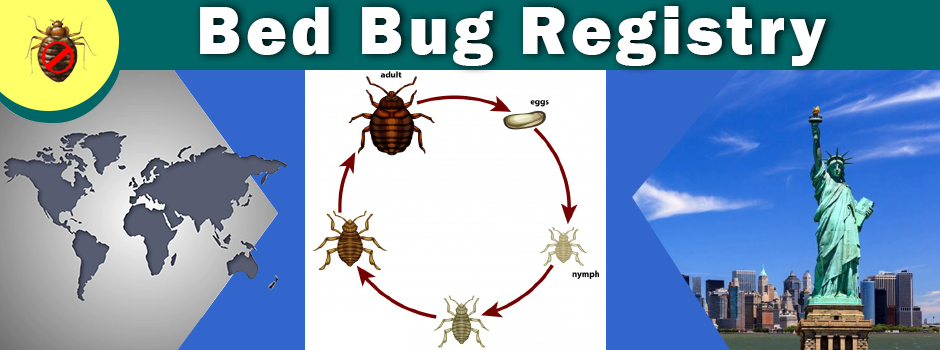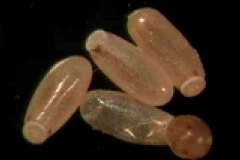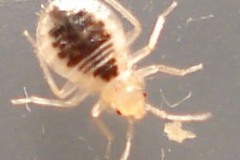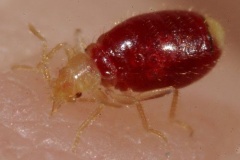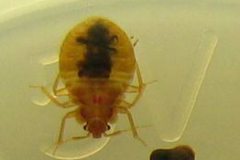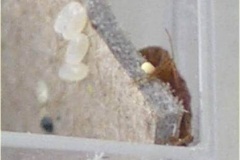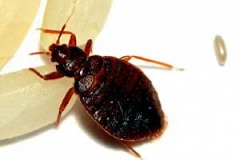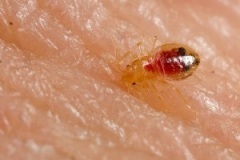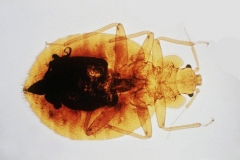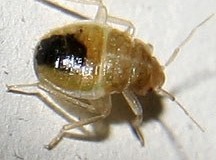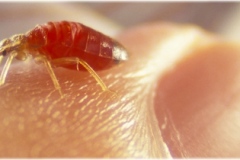Bed bugs get their name from their favorite feeding ground: You, in your own bed. These blood-suckers live in or near beds or other textiles, crawling up to bite you as you sleep, sometimes leaving you with itchy red marks or welts. Under optimal conditions, bed bugs can double their population every 16 days. But what exactly are bed bugs? How do you identify them, where do they live, and what should you do if you suspect your home might be infested? Read on to learn more.
Bed bugs are small, parasitic insects that feed on human blood, usually at night. They can be found in nearly every corner of the world. The common bed bug is the most widespread species, though there are a few other species that can be found in certain parts of the world. The common bed bug is the one you would most likely find in your home if you live in the United States.
Reports of these pests have been on the rise in recent decades. Bed bugs also tend to spread quickly from place to place, which makes them bad news for just about everybody. Schools, hotels, movie theaters and other structures have been shut down because of bed bug infestations.
If you think you may have bed bugs in your home, it's important to be able to identify them. Bed bugs look different at different stages of their life cycle, but they tend to be from one to three millimeters long. Adult bed bugs are oval shaped and brown or reddish brown in color. They are also very thin and flat, which makes it easy for them to squeeze in tight places. After feeding, however, their bodies get longer and more red in color.
In their nymph stage, bed bugs may be tan, white, yellowish or nearly transparent, and will be much smaller than adults. Bed bugs feed on blood at all stages of their life.
If you wake up in the morning with itchy, red bites on your body, this may be one of the signs that you've been bitten by bed bugs. It's important to note, though, that not all people react to bed bug bites, so you may have bed bugs even if you don't notice you've been bitten. However, there are some telltale signs of bed bug bites that may tip you off to having been bitten.
For many people, though, bed bug bites look like small, raised, red welts, and they often appear in lines or clusters. They are much smaller than mosquito bites, but are often quite itchy.
Are bed bugs dangerous? Bed bug bites are annoying, but luckily, these pests aren't known to carry disease like mosquitoes and other parasites do. However, some people may have severe allergic reactions to bites, or scratching bed bug bites may lead to skin infections, according to the CDC.
Knowing more about bed bug behavior and these creatures' habits can help you learn more about how to prevent them and protect yourself from an infestation. In this section, we'll look at how and when they feed, and their life cycle.
Bed bugs will feed on any warm-blooded mammal. It's easier for them to bite humans, though, as we are not covered in thick fur like pets. Bed bugs tend to feed while we are asleep and are attracted to bodily warmth and the carbon dioxide humans exhale. This attracts them to a reliable source of blood so they can feed.
Bed bugs can feed as often as once a day and need to feed before molting. It only takes them a few minutes to feed before they go back into hiding for the rest of the night.
Nymph and adult bed bugs derive their food source from the blood of animals, including humans. A bed bug's life begins with a five-stage growth cycle to adulthood over about 37 days.
As adults, they can live for about a year, depending on their access to food and the ambient temperature. An adult female bed bug can lay roughly 113 eggs in her lifetime. At this rate, bed bug populations can double every 16 days. With thousands of bed bugs in one location, infestations take hold quickly.
Here's a little more about the life cycle of a bed bug:
Bed bug nymphs are tiny -- only around a millimeter long. They are usually whitish in color, but are ready to feed as soon as they hatch.
In this stage, the bug grows a little and starts to darken in color. While they're still tiny, they are about to shed their skin and grow again.
In this stage, just as in previous stages, the bug has grown a little more, reaching about three millimeters in length.
The bug continues to grow, feed and shed its skin. It has nearly reached maturity.
In this stage, the bug is nearly full grown and must feed and shed its skin once more before adulthood.
In just over a month, the bug has gone from an egg to an adult. It is now ready to mate and create potentially hundreds more bugs in your home.
After the male and female bed bugs mate, the female requires a blood meal to produce eggs. The female bed bug typically produces between 5 and 20 eggs per blood meal. Most of the eggs hatch and mature in 37 days. Because they can store fertilized eggs for some time, female bed bugs can reproduce even when apart from males.
Because they reproduce so quickly, bed bug infestations can spread rapidly, especially in homes with shared walls like apartments or townhomes. They can climb through tiny cracks and will stay hidden until they're ready to feed.
Bed bugs are also notorious hitchhikers. They will cling onto your clothes, shoes or luggage when you travel, and will set up a nest wherever they happen to land. This is why they can be such a problem in hotels, office buildings, schools and other public places.
Bed bugs are attracted to humans due to the carbon dioxide they exhale, along with other chemical cues released while we are sleeping. These pests have one mission - to feed on your blood. Bed bugs do not prefer dirty homes over clean homes. They don't care about where they nest, as long as they have access to a regular supply of blood.
If you live in an apartment or in a housing unit that shares walls with another unit, you may be more at risk for bed bugs. Because bed bugs will crawl to find more human hosts when their nest grows, high density residences and frequently traveled places like hotels and taxis become bed bug transportation stations. Buying used furniture is another way to acquire bed bugs at home.
The best way to reduce your bed bug risk is to carefully check for them when you are changing your bed, returning home with luggage and buying used items. Examine these items outside before bringing them into your home.
Bed bugs like to cluster together near their human host's bed, so they don't have to travel far to their next feeding. It can get crowded quickly there, so bed bugs may hide in extremely tight places nearby, which makes them difficult to get rid of.
If you miss the bugs hiding in nearby furnishings, carpet edges, or even wallpaper, these outliers can reestablish their home in your bed in a matter of weeks. Bed bugs can be a nightmare to treat, especially if you try to do it yourself.
Common places bed bugs hide include electrical sockets, bed frames, mattresses, between couch cushions, in the zippers of pillows and anywhere they aren't often disturbed. They quickly scurry out of that hiding place once every few days to feed, and then they hide away until they're hungry again.
There are a few common signs that you may have bed bugs in your home. Of course, as mentioned above, bites are a big warning that you may be housing an infestation.
You can also look for dark stains on your bedsheets, which may be bed bug feces. You can also be on the lookout for bloodstains on your sheets or clothing. Bed bug eggs, shells, and live bed bugs are less commonly seen, but can also be sure signs that you have a problem.
Because they are so small and difficult to spot, bed bugs can be difficult to get rid of. If you think you have bed bugs in your home, it's important to call a bed bug control professional. When you call Terminix for a free inspection, a pro will first confirm whether you have bed bugs by identifying a sample. Then they'll be able to discover the extent of the infestation, and provide you with customized treatment options to help take care of your bed bug problem. Call Terminix today for a free inspection.
Probably not, but these facts about bed bugs will dispel common myths and might actually give you some comfort while you sleep tonight. At the very least, youll learn that there wont be any bed bugs flying over your pillow. Unfortunately, that doesnt mean they cant crawl.
If youve ever thought you might be able to starve bed bugs to death by not sleeping in an infested room for a while, you are out of luck. In some cases, bed bugs have been known to survive more than a year without a blood meal.
Bed bugs might be just as lazy as their name suggests. While they dont limit themselves to hiding in beds, they do limit the amount of exercise they are willing to commit to for the sake of a meal. Some bed bugs will travel up to 100 feet in search of a host, but on average, most bed bugs wont travel more than 30 feet.
Perhaps part of the reason that bed bugs prefer not to travel has to do with their speed. Bed bugs can only move about 3 to 4 feet per minute. On a flat surface without any obstacles in the way, it would take a bed bug almost an entire day to move just 1 mile.
Among all of these other facts about bed bugs, this one might be especially comforting. Bed bugs dont have any hind wings and their front wings are no more than wing-like pads. As such, they are unable to fly. They also dont jump.
If you are suspicious about a small piece of furniture in your home containing bed bugs, place it in the bathtub until you have a chance to inspect and clean it. Just make sure the bathtub is clean. While bed bugs are hopeless against a perfectly smooth surface, they can sometimes use the dirt on an otherwise slippery side, in order to escape.
The idea of basking in the hot sand all day would not be particularly attractive to a bed bug. In fact, in temperatures over 110 degrees Fahrenheit, bed bugs cant live for more than three or four hours.
You are likely to be haunted by any insect that sneaks up on you at night, but bed bugs can have a particularly ghost-like appearance. A newly matured, nymph bed bug, or one that hasnt fed for a very long time, will appear translucent. Bed bugs only gain color after they have had a blood meal. After its very first meal, a nymph bed bug will turn bright red.
After taking a break from tormenting the human population, bed bugs have made a major resurgence over that past few years. This has led to a number of lawsuits regarding bed bugs. One of the biggest payouts as a result of a bed bug lawsuit was more than $600,000.
If these facts about bed bugs havent exactly brought on the comfort of counting sheep, consider calling a pest management professional. Call Terminix today and you can schedule a free bed bug inspection. Or, you could just count the bed bugs until they put you to sleep. Sounds soothing, right?
Read more here:
Bed Bugs: Facts, Information and Pictures | Terminix

 Residence
Residence  Location
Location 
